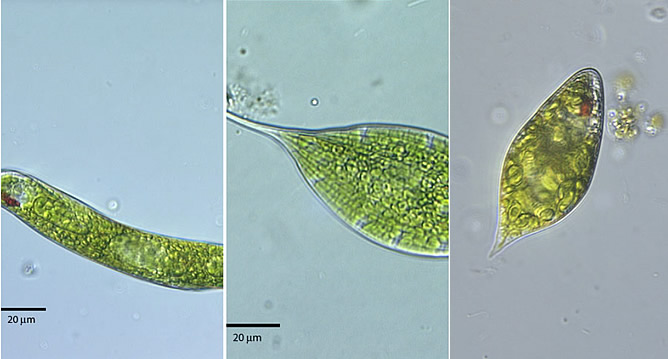| Cell | Chlorophyll | Pigments | Membranes | Thylakoids | Storage | Covering | Flagella |
|---|---|---|---|---|---|---|---|
| Eukaryotic | a and b | None | 3 | 3 | paramylon | protein, lipid and carbohydrate | 1-2 emergent |

| Jason Oyadomari | Jason Oyadomari | Jason Oyadomari |
Euglenoids are algae with a unique cell covering (a pellicle), and although many species are photosynthetic, they tend to supplement photosynthesis with absorption of organic compounds and many species engulf their prey.
Species within the division Euglenophyta reach their greatest abundance in small pools, stagnant waters, or ditches that have been enriched with organic compounds, often from human pollutants. They grow mostly in freshwater habitats, but they also can form large blooms in coastal marine areas in association with the presence of certain organic compounds. Therefore, while euglenoids may photosynthesize by using the pigments chlorophyll a and b, they also have the ability to absorb organic compounds. Other species are phagotrophic, that is, they are able to capture prey and engulf them. This type of nutrition (heterotrophy) is well developed in euglenoids. Over the course of evolutionary history, some species have lost their chloroplasts and, therefore, their ability to photosynthesize. Euglenoids also have a unique cell covering called the pellicle, which allows the cells to move with a characteristic, squirming “euglenoid” movement.
Structure
The pellicle is composed of narrow strips of protein that wind around the exterior part of the cell. These flexible strips allow the cell to change shape easily as the flagella propel the cell through water. Cells also possess an “eyespot”, which is composed of dense, pigmented granules. This eyespot is sensitive to light and appears to interact with the flagella to direct movement. At one end of the cell are two flagella, which are usually unequal in length. The base of flagella is a “reservoir”, a structure that is also involved in ingestion of particles of food. The chloroplasts of the euglenoids lack accessory pigments, so cells usually appear green in color (from chlorophyll a and b).
Euglenoids in Rocky Mountain Lakes
Euglenoids are rare in the low nutrient waters of Rocky Mountain lakes. One genus that does occur is Trachelomonas, which has a rigid lorica (covering) that surrounds the cell.
1 taxa shown below, 1 of which appear in at least one sample.
| Name | Basionym | Synonyms | Lakes | Samples | Region* | ID |
|---|---|---|---|---|---|---|
| Trachelomonas sp. | 1 | 1 | RMNP, | 6001 |
Region:
RMNP = Rocky Mountain National Park, CO
Representative images missing for: Trachelomonas sp. |

